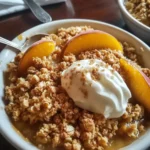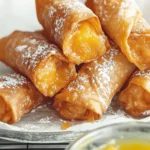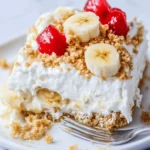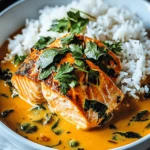A beautifully smoked prime rib is the epitome of a show-stopping meal. The succulent, tender meat with its flavorful herb crust is a delight to both the eyes and the palate. Served with a rich wine-butter sauce, each bite is packed with smoky depth and savory goodness.
The smoky aroma that fills the air as this roast is cooking is enough to make anyone’s mouth water. Once it’s done, this prime rib roast will become your go-to centerpiece for any special occasion or holiday dinner. Whether paired with mashed potatoes or roasted vegetables, it’s sure to be the star of your meal.
Full Recipe:
-
1 (4-5 pounds) bone-in prime rib roast, tied
-
2 tablespoons olive oil
-
2 teaspoons kosher salt
-
1 teaspoon freshly ground black pepper
-
2 tablespoons fresh rosemary, finely chopped
-
1 tablespoon garlic, minced
-
1 tablespoon fresh thyme, chopped
-
2 teaspoons Dijon mustard
-
1 cup beef broth
-
1/4 cup red wine
-
1/4 cup butter, softened
Directions:
-
Preheat your smoker to 225°F. Place a drip pan with beef broth underneath the smoker grates to catch drippings.
-
Rub the prime rib with olive oil, then season generously with kosher salt, pepper, rosemary, thyme, garlic, and Dijon mustard. Make sure to coat it evenly on all sides.
-
Insert a meat thermometer into the thickest part of the roast, avoiding the bone. Place the prime rib on the smoker grate and smoke until the internal temperature reaches 120°F for rare, 130°F for medium-rare, or 140°F for medium (about 3-4 hours depending on the size).
-
Once it reaches your desired doneness, remove the roast from the smoker and let it rest, covered loosely with foil, for 15-20 minutes.
-
While the roast is resting, pour the red wine into the drip pan to deglaze it, scraping up any flavorful bits from the bottom. Simmer for 3-5 minutes, then whisk in the butter until the sauce is smooth.
-
Slice the prime rib against the grain and serve with the wine-butter sauce.
Prep Time: 20 minutes | Cooking Time: 3-4 hours | Total Time: 3 hours 30 minutes – 4 hours 20 minutes
Kcal: 350 kcal (per serving) | Servings: 8 servings
History and Origin
Prime rib has long been a beloved centerpiece in many Western culinary traditions, especially during festive occasions. The term “prime rib” refers to a cut of beef that is selected from the primal rib section of the cow, a part that is known for its marbling and tenderness. The “prime” part of its name refers to the quality of the meat, which is typically USDA prime grade, though choice cuts are also commonly used.
While roasting prime rib has been the more traditional method of cooking, smoking has become an increasingly popular technique in recent years. Smoking meat dates back hundreds of years as a means of preservation and flavoring. Early methods involved hanging meat over an open fire or using a basic pit or smoker to slow-cook meat with wood, infusing it with a smoky aroma. The process of smoking meats slowly at low temperatures enhances the flavors while keeping the meat moist and tender. Today, smokers and pellet grills are commonly used to achieve this, combining the best of traditional and modern cooking techniques.
Although the smoked version is newer compared to the classic oven-roasted prime rib, it has quickly gained popularity for its rich, smoky flavor and juicy texture. Smoked prime rib brings together two things: a perfect, well-marbled cut of beef and the flavor-enhancing powers of wood smoke. It’s not just about cooking; it’s about crafting a culinary experience that highlights the beef’s natural flavors and takes advantage of the slow cooking method.
Variations and Adaptations
Prime rib, in its smoked form, can be adapted to suit a variety of tastes and preferences. One of the most common variations involves changing the wood used for smoking. Different woods impart different flavors to the meat. For example, hickory and oak tend to offer a stronger, bolder smoke flavor, while fruit woods like apple and cherry provide a milder, sweeter flavor. The choice of wood can have a profound impact on the final taste, so experimenting with different types of wood can give your smoked prime rib a unique twist each time.
Another variation lies in the seasoning or rub applied to the meat. Traditional prime rib recipes often use simple salt, pepper, and garlic, but the smoked version can include a wide range of spices and herbs. Some people prefer to create a more complex rub with ingredients like paprika, mustard powder, thyme, and rosemary, adding layers of flavor to the beef. A mustard-based rub is also popular, offering a tangy contrast to the richness of the meat. Additionally, some variations incorporate a glaze or sauce, such as a red wine reduction, garlic butter, or horseradish cream, which can enhance the flavor profile and add a touch of richness.
For those seeking a more adventurous flavor, smoked prime rib can also be paired with marinades or brines. A marinade with balsamic vinegar, soy sauce, or Worcestershire sauce can tenderize the meat while imparting savory flavors. Alternatively, a brine using salt, sugar, and aromatics like bay leaves, garlic, and peppercorns helps keep the meat moist while infusing it with flavor.
Nutritional Information
Prime rib is undeniably a rich and indulgent dish, packed with protein and essential nutrients. However, it’s important to enjoy it in moderation, as it also contains a fair amount of fat and calories.
In a typical serving of smoked prime rib (approximately 4 ounces), you’ll find around 350-400 calories. The protein content is substantial, typically around 25-30 grams per serving, making it an excellent source of protein for muscle building and repair. As for fats, prime rib contains about 20-25 grams of fat per serving, with a good portion of that being saturated fat. While saturated fats are often a point of concern for heart health, they are naturally occurring in this rich cut of beef.
In addition to protein and fat, prime rib is also a good source of essential vitamins and minerals, including iron, zinc, and B vitamins such as niacin, riboflavin, and B12. These nutrients are crucial for energy production, immune function, and red blood cell formation. Iron, in particular, is important for oxygen transport in the blood, and the heme iron found in beef is more easily absorbed by the body compared to plant-based iron sources.
Although prime rib is nutrient-dense, it’s important to balance this rich dish with plenty of vegetables, fruits, and whole grains to ensure a well-rounded meal. Pairing your smoked prime rib with a light salad or roasted vegetables can help offset the richness of the meat and provide a healthy dose of fiber, vitamins, and antioxidants.
Serving Suggestions and Pairings
Smoked prime rib is a versatile dish that pairs well with a wide range of sides and beverages. Its bold flavors call for accompaniments that complement, rather than overpower, the beef.
Classic side dishes such as mashed potatoes, roasted Brussels sprouts, and Yorkshire pudding make for a comforting and traditional pairing. For a slightly lighter approach, you might consider serving smoked prime rib alongside a fresh arugula salad, dressed with a lemon vinaigrette to cut through the richness of the meat.
For a more indulgent meal, serve the prime rib with a creamy potato gratin or roasted sweet potatoes. The natural sweetness of the sweet potatoes pairs wonderfully with the smoky flavor of the beef, adding a contrasting flavor profile to each bite.
When it comes to beverages, red wine is the obvious choice for pairing with smoked prime rib. A bold red wine like Cabernet Sauvignon or Syrah enhances the smoky richness of the beef, while the tannins in the wine help balance the fat content of the meat. If you prefer beer, opt for a robust porter or stout, which can stand up to the deep flavors of the smoked prime rib.
For a more adventurous pairing, try a smoky mezcal cocktail or a bourbon-based drink. The smoky undertones in these spirits can echo the flavors in the meat, creating a harmonious dining experience.
Advertisement
Tips and Tricks for Success
-
Choose the right cut: When making smoked prime rib, selecting the best cut of beef is crucial. Opt for bone-in prime rib for maximum flavor and tenderness. The bone helps retain moisture during the smoking process and enhances the beef’s flavor.
-
Season generously: Prime rib is a naturally flavorful cut of meat, but a well-seasoned rub can elevate the flavor even further. Don’t be afraid to season the meat generously with salt, pepper, and herbs. This will create a delicious crust that contrasts with the tender interior.
-
Monitor the internal temperature: Smoking times can vary depending on the size of the roast and the temperature of your smoker. The key to perfect smoked prime rib is monitoring the internal temperature. Aim for 120°F for rare, 130°F for medium-rare, or 140°F for medium. Use a meat thermometer to ensure precise results.
-
Rest before slicing: Once the prime rib is done, let it rest for at least 15-20 minutes before slicing. This allows the juices to redistribute within the meat, ensuring that each slice is as juicy and tender as possible.
Potential Health Benefits
While smoked prime rib is not exactly a health food, it does offer several health benefits due to the quality of its ingredients. The high protein content supports muscle repair and overall body function. The iron and zinc in prime rib are particularly beneficial for people who have higher iron needs, such as those with anemia or pregnant women. Additionally, the healthy fats in prime rib can contribute to maintaining skin health and hormone balance when consumed in moderation.
However, it’s important to be mindful of the fat and calorie content, especially for those who are watching their weight or cholesterol levels. By balancing smoked prime rib with fiber-rich vegetables and whole grains, you can enjoy the dish as part of a healthy, well-rounded meal.
Conclusion
Smoked prime rib is a dish that brings the best of both worlds – it’s a perfect combination of flavor, texture, and aroma. Whether you’re a seasoned griller or new to smoking meats, this recipe offers a rewarding challenge and a delicious result. The deep smoky flavor, tender meat, and herb crust make it the perfect centerpiece for any occasion. Try it out for your next holiday meal, barbecue, or family gathering, and prepare to wow your guests with a true showstopper of a dish!






